Old Town
RSP 13257
Grower: The medicinal plant research institute/Lampang Thailand
General Information
- Sample Name
- CS195-20241021
- Accession Date
- October 20, 2024
- Reported Plant Sex
- Not Reported
- Report Type
- Whole-Genome Sequencing
The strain rarity visualization shows how distant the strain is from the other cultivars in the Kannapedia database. The y-axis represents genetic distance, getting farther as you go up. The width of the visualization at any position along the y-axis shows how many strains there are in the database at that genetic distance. So, a common strain will have a more bottom-heavy shape, while uncommon and rare cultivars will have a visualization that is generally shifted towards the top.
Chemical Information
Cannabinoid and terpenoid information provided by the grower.
Cannabinoids
No information provided.
Terpenoids
No information provided.
Genetic Information
- Plant Type
- Type I
File Downloads
The bell curve in the heterozygosity visualization shows the distribution of heterozygosity levels for cannabis cultivars in the Kannapedia database. The green line shows where this particular strain fits within the distribution. Heterozygosity is associated with heterosis (aka hybrid vigor) but also leads to the production of more variable offspring. When plants have two genetically different parents, heterozygosity levels will be higher than if it has been inbred or backcrossed repeatedly.
The ratio of reads mapped to Y-contigs to reads mapped to the whole Cannabis genome (Y-ratios) has been demonstrated to be strongly correlated with plant sex typing. This plot shows the distribution of Y-ratios for all samples in our database which were sequenced with the same method (panel or WGS) as this sample and where this sample falls in the distribution.
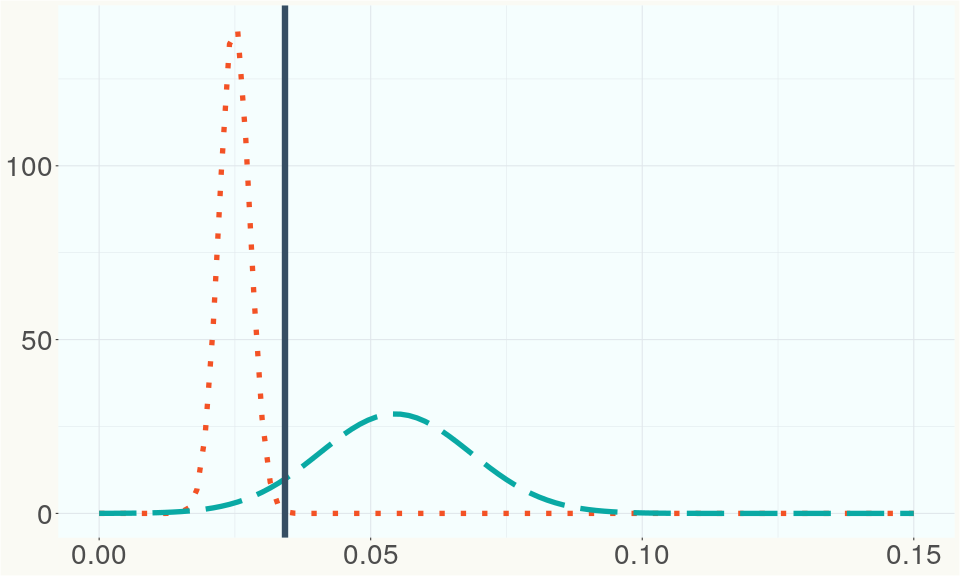
This chart represents the Illumina sequence coverage over the Bt/Bd allele. These are the three regions in the cannabis genome that impact THCA, CBDA, CBGA production. Coverage over the Active CBDAS gene is highly correlated with Type II and Type III plants as described by Etienne de Meijer. Coverage over the THCA gene is highly correlated with Type I and Type II plants but is anti-correlated with Type III plants. Type I plants require coverage over the inactive CBDA loci and no coverage over the Active CBDA gene. Lack of coverage over the Active CBDA and Active THCA allele are presumed to be Type IV plants (CBGA dominant). While deletions of entire THCAS and CBDAS genes are the most common Bt:Bd alleles observed, it is possible to have plants with these genes where functional expression of the enzyme is disrupted by deactivating point mutations (Kojoma et al. 2006).
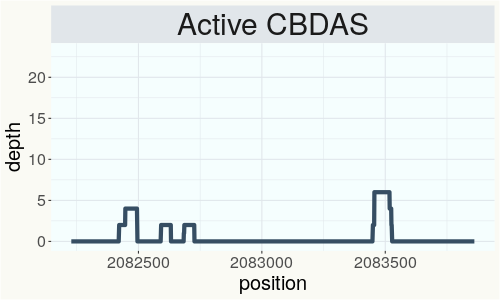
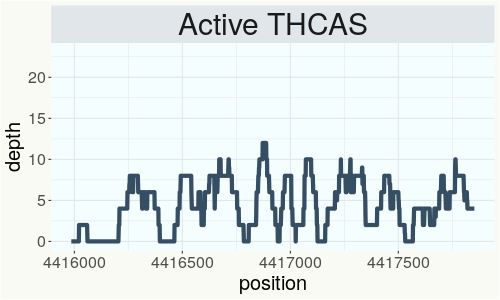
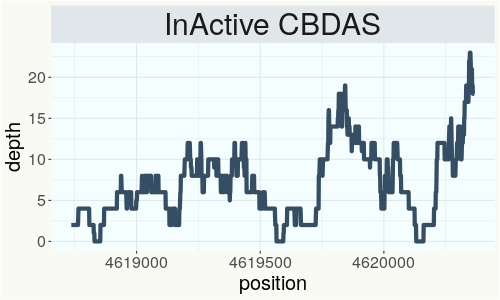
This chart represents the Illumina sequence coverage over the CBCA synthase gene.
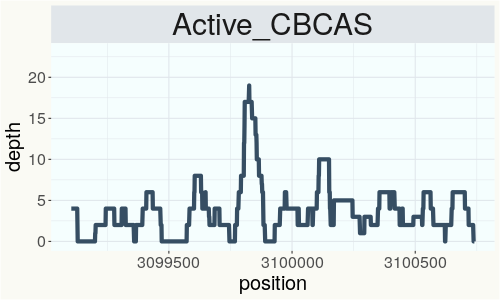
Variants (THCAS, CBDAS, and CBCAS)
No variants to report
Variants (Select Genes of Interest)
| PHL-2 | c.1096G>A | p.Ala366Thr | missense variant | moderate | contig2621 | 340374 | G/A | |
| PHL-2 |
c.3556_3557d |
p.Lys1186fs | frameshift variant | high | contig2621 | 343598 | GAA/G | |
| ELF3 | c.740A>G | p.Glu247Gly | missense variant | moderate | contig97 | 242446 | A/G |
|
| ELF3 | c.772A>G | p.Ser258Gly | missense variant | moderate | contig97 | 242478 | A/G |
|
| HDS-2 | c.127T>G | p.Ser43Ala | missense variant | moderate | contig95 | 1989794 | T/G |
|
| AAE1-3 | c.181G>A | p.Val61Ile | missense variant | moderate | contig976 | 1083894 | C/T |
|
| AAE1-3 | c.179C>T | p.Thr60Ile | missense variant | moderate | contig976 | 1083896 | G/A |
|
| PKSB-3 | c.1901C>G | p.Ala634Gly | missense variant | moderate | contig93 | 3340008 | C/G |
|
| PKSB-3 | c.1978A>G | p.Asn660Asp | missense variant | moderate | contig93 | 3340085 | A/G |
|
Nearest genetic relatives (All Samples)
- 0.250 RKM-2018-027 (RSP11119)
- 0.257 Blue Dream (RSP11006)
- 0.260 BLACK JACK (RSP11346)
- 0.264 RKM-2018-025 (RSP11117)
- 0.265 RKM-2018-016 (RSP11108)
- 0.267 Black Jack (RSP10603)
- 0.269 Blue Dream (RSP11017)
- 0.272 Blue Dream (RSP11010)
- 0.275 Blueberry Cheesecake (RSP10684)
- 0.276 Durban Poison (RSP11014)
- 0.288 Blue Dream (RSP11012)
- 0.290 Blue Dream (RSP11008)
- 0.292 Electra (RSP11366)
- 0.295 Snoops Dream (RSP11003)
- 0.295 Super Blue Dream (RSP11011)
- 0.296 UP Sunrise (RSP10989)
- 0.297 Durban Poison (RSP10998)
- 0.298 Blue Dream (RSP11004)
- 0.299 Doug s Varin (RSP11243)
- 0.300 Durban Poison 1 (RSP10996)
Most genetically distant strains (All Samples)
- 0.466 Carmaleonte (RSP11207)
- 0.466 CS (RSP11208)
- 0.459 Cherry Blossom (RSP11314)
- 0.456 Arcata Trainwreck (RSP11176)
- 0.456 Rainbow Belts 1 0 (RSP12911)
- 0.451 JL 3rd Gen Father (RSP11196)
- 0.451 Feral (RSP11205)
- 0.449 Feral (RSP11206)
- 0.447 Feral (RSP10890)
- 0.447 Feral (RSP10891)
- 0.445 Rainbow Belts 3 0 11 (RSP12801)
- 0.444 Monoica (RSP10241)
- 0.443 R1in136 (SRR14708226)
- 0.442 AST 530 (RSP13256)
- 0.442 Carmagnola (RSP11202)
- 0.442 Right Mark (RSP11628)
- 0.441 Santhica27 (RSP10056)
- 0.441 Guru G 6 (RSP12864)
- 0.441 Tiborszallasie (RSP11210)
- 0.440 80E (RSP11213)
Nearest genetic relative in Phylos dataset
- Overlapping SNPs:
- 5
- Concordance:
- 4
Nearest genetic relative in Lynch dataset
- Overlapping SNPs:
- 4
- Concordance:
- 4
Blockchain Registration Information
- Transaction ID
-
RSP13257-mgc-ots
-certificate - Stamping Certificate
- Download PDF (1.2 MB)
- SHASUM Hash
-
f6780211e2e4c9360c4738dfd1138c72 62f8fe91c485475e 257e29700fe23670